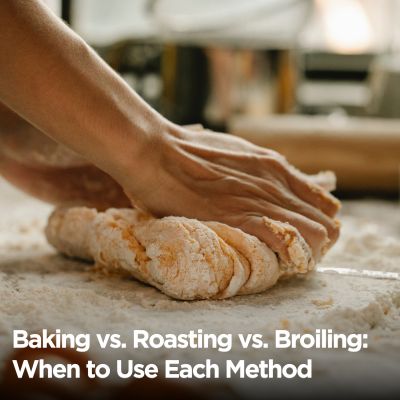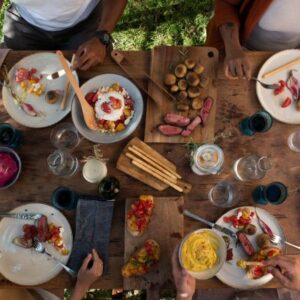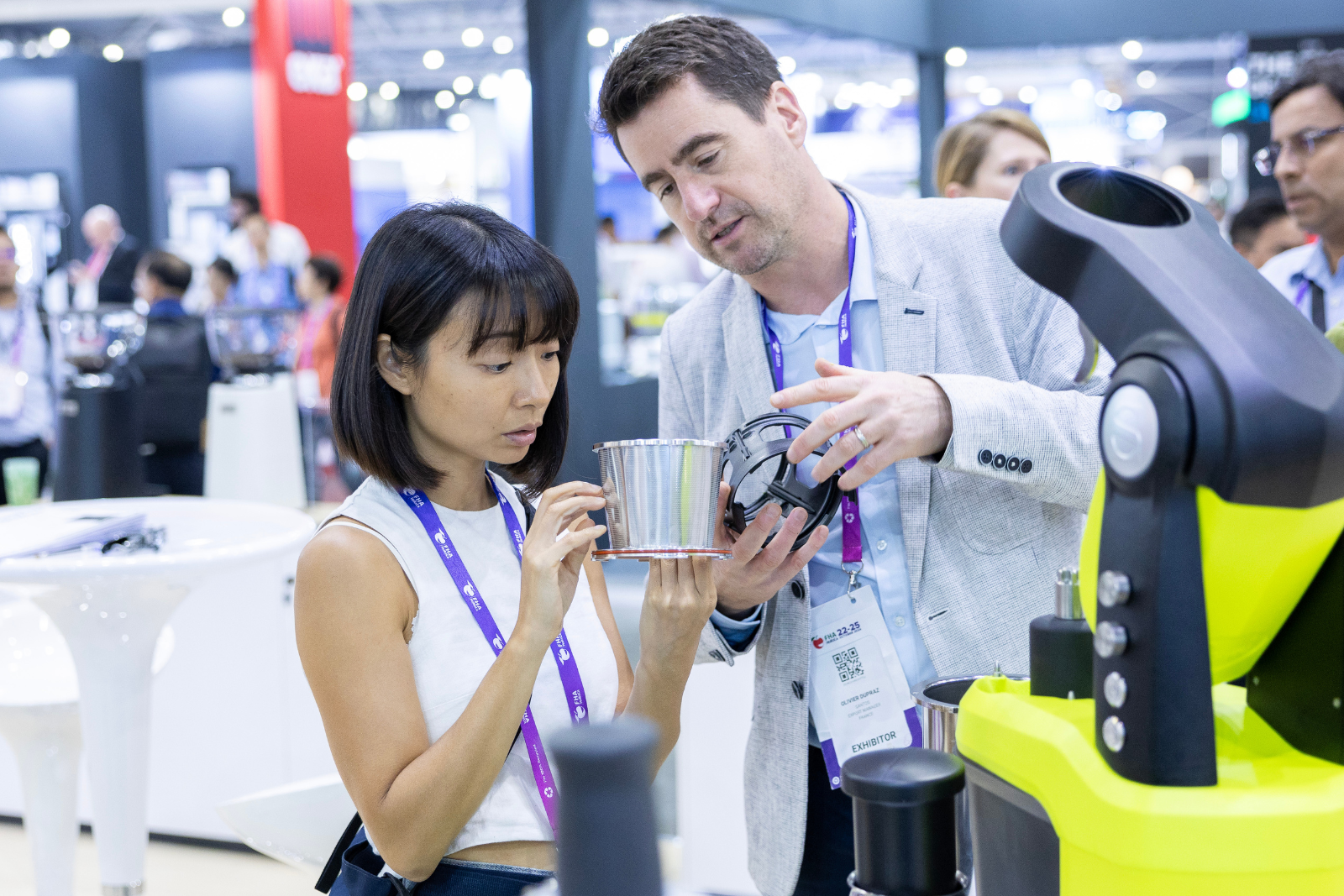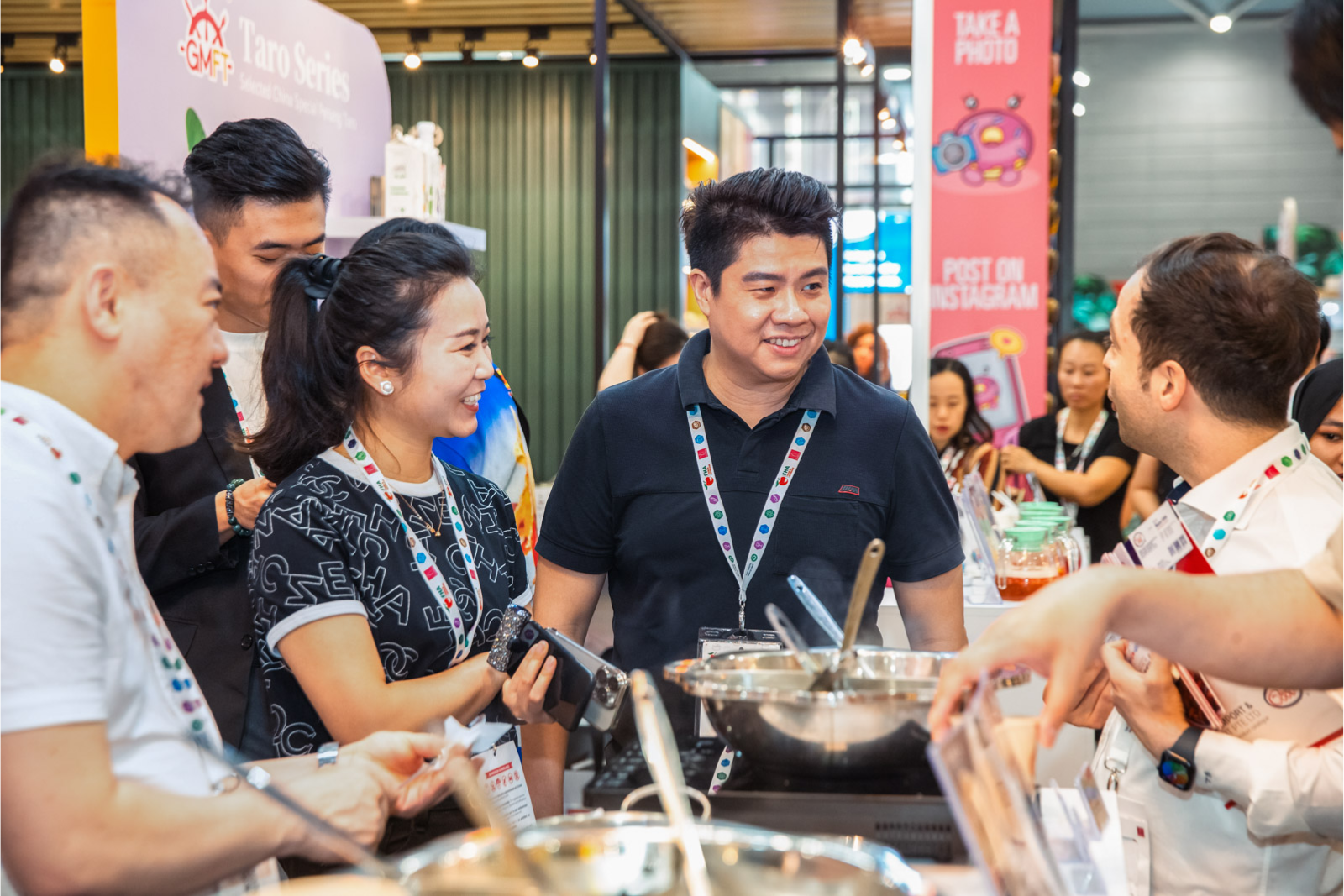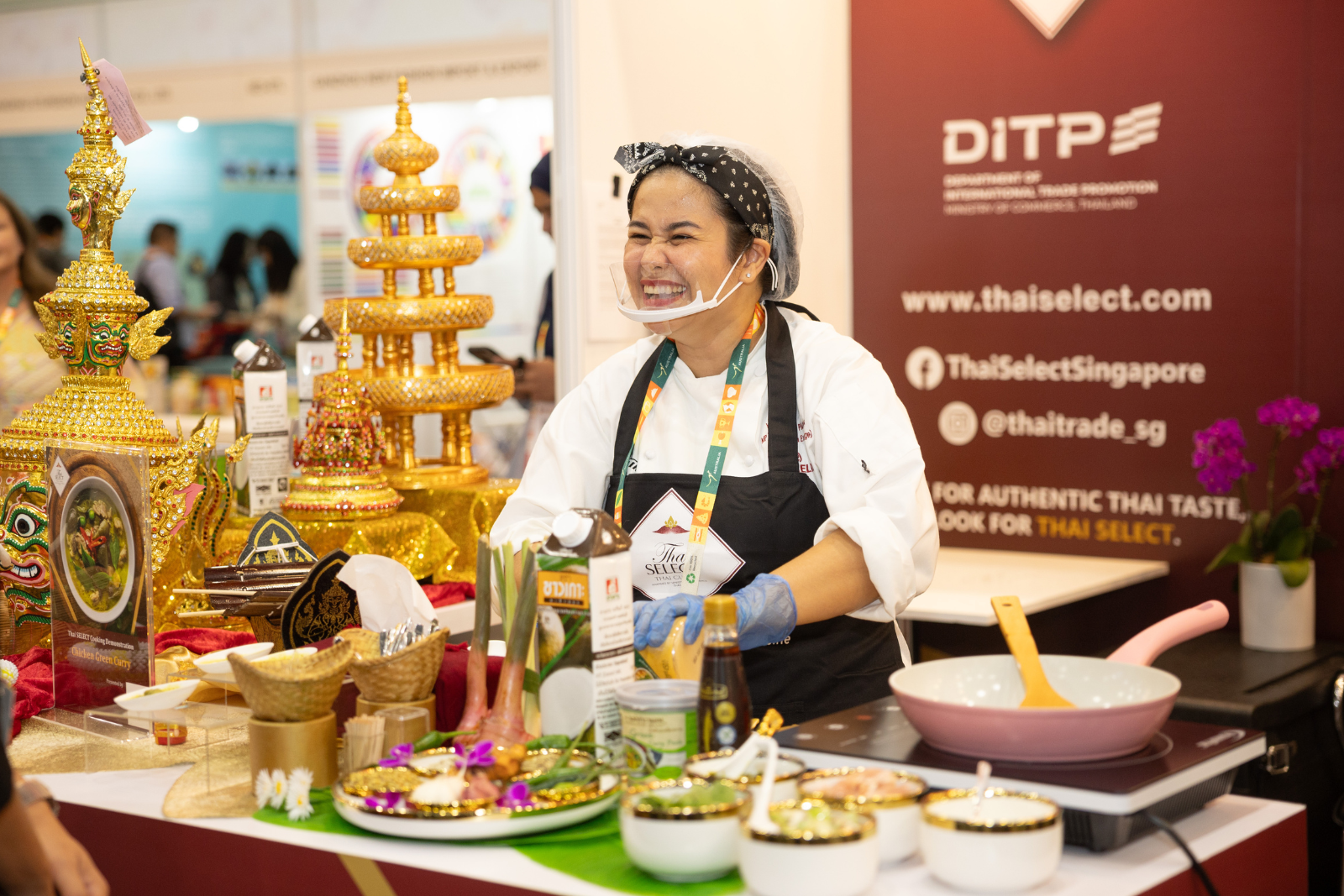As any cook will tell you, the method you use to prepare your food can make all the difference in how a dish turns out. That’s why understanding baking vs. roasting vs. broiling is important for creating delicious and perfectly cooked meals.
While these techniques might seem similar initially, each uniquely enhances flavors and textures, turning even the simplest ingredients into something special.
Whether roasting vegetables to crispy perfection, baking a soft and fluffy loaf of bread, or broiling a steak with the perfect char, choosing the right method can enhance your cooking.
In this blog, we’ll explore the difference between baking, roasting, and broiling, explain when to use each technique, and share some equipment recommendations and recipe ideas to help you get started. With just a little practice, you’ll be able to bring out the best in every dish.
Let’s jump right in!
What is Baking?
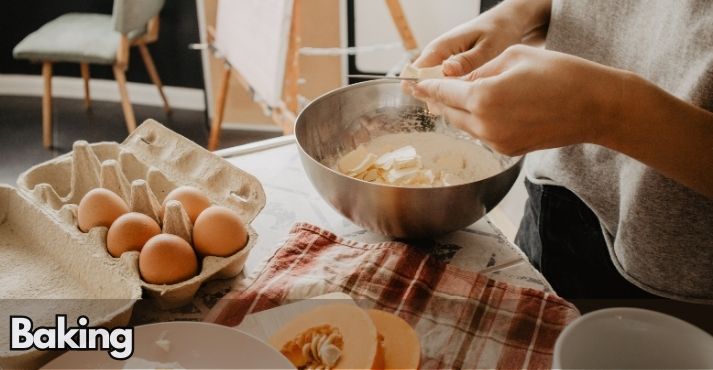
Baking is cooking with dry, indirect heat in an oven. This method is commonly used for creating baked goods like cakes, cookies, pastries, casseroles, and some meats.
By surrounding food with dry heat, baking allows for even cooking, resulting in a golden-brown crust and tender interior. Whether it’s puff pastry, phyllo dough, or a hearty casserole, the even heat distribution is essential for achieving the desired texture and flavor.
43% of home bakers say that baking brings them comfort, providing satisfaction with every batch of cookies or loaf of bread they make. It’s a method that’s not just about cooking but about creating something that feels rewarding and cozy.
Equipment Used in Baking
To begin baking, you’ll need a few essential tools in your kitchen. Some of the most common equipment includes:
- Ovens: Essential for baking, they provide consistent and controlled heat to cook doughs and batters evenly.
- Baking Pans: Round, square, or loaf pans for cakes, bread, or casseroles.
- Baking Sheets: Great for cookies, pastries, and other treats that need to spread out.
- Mixing Bowls: Required for combining ingredients.
- Measuring Spoons and Cups: Accurate measurements are necessary for successful baking, especially when making delicate pastries or cakes.
Simple Recipe for Baking: Chocolate Chip Cookies
Let’s put baking into practice with a simple recipe for chocolate chip cookies. These cookies are a great introduction to baking and will be a hit at any gathering or cafe you visit.
Ingredients:
- 2 1/4 cups all-purpose flour
- 1/2 cup butter, softened
- 1 cup sugar
- 2 large eggs
- 2 cups chocolate chips
- 1 tsp vanilla extract
- 1 tsp baking soda
Instructions:
- Preheat the oven to 350°F.
- Combine the butter, sugar, and eggs in a large mixing bowl. Add vanilla extract and mix until smooth.
- Gradually add the flour and baking soda, mixing until well combined.
- Stir in the chocolate chips.
- Scoop tablespoon-sized amounts of dough onto a baking sheet lined with parchment paper.
- Bake for 10-12 minutes, or until golden brown.
Tips:
- Always preheat your oven to the correct temperature to ensure even baking.
- If you’re working with moist cooking methods for other recipes, like roasting or braising, remember that baking requires dry heat for the best results.
- Use parchment paper or grease your pans to prevent sticking, especially with delicate pastries like puff pastry and phyllo dough.
- Measure your ingredients properly to ensure the best texture in your baked goods.
Baking doesn’t just allow you to enjoy delicious treats, but it can also bring comfort and joy. Whether perfecting a classic recipe or experimenting with new flavors, baking always brings a sense of warmth to your kitchen.
What is Roasting?
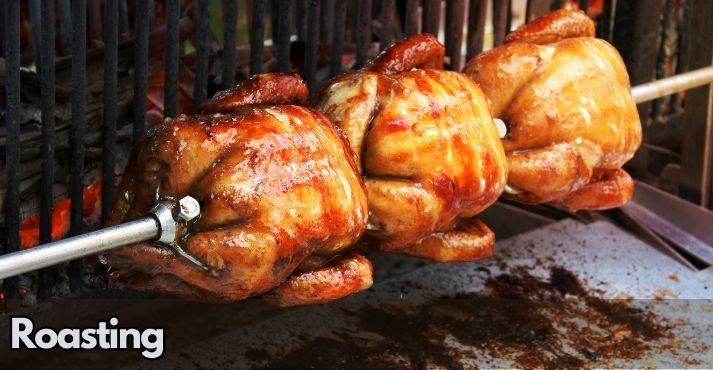
Roasting is a cooking method that uses high, dry heat to cook food evenly, often in an oven. The intense heat helps create a beautifully crispy or caramelized exterior, while keeping the interior tender and juicy.
Roasting is popular for vegetables, meats, and poultry, where the goal is to enhance natural flavors and textures. Whether preparing a tray of roasted vegetables or a whole roasted chicken, the even heat distribution is essential for achieving that perfect, golden-brown finish.
The versatility of roasting also makes it ideal for enhancing continental food dishes, from roasted root vegetables to succulent roasted meats.
Equipment Used in Roasting
Having the right equipment is essential for achieving the best results when roasting. Some common tools include:
- Roasting Pans: Ideal for meats and large vegetables, designed to fit into your oven while allowing heat to circulate evenly.
- Sheet Pans: Perfect for smaller vegetables and quick roasting.
- Tongs: Handy for turning food while roasting to ensure even cooking.
- Basting Brushes: Used to apply sauces or liquids during the roasting process for added flavor and moisture.
- Meat Thermometers: An essential tool when roasting meats, allowing you to monitor internal temperatures for perfectly cooked poultry or meat.
Simple Recipe for Roasting: Roasted Vegetables
Let’s try a simple and tasty recipe for roasted vegetables, which can be a great side dish for any meal.
Ingredients:
- 3 carrots, peeled and chopped
- 3 potatoes, chopped
- 2 bell peppers, chopped
- 2 tbsp olive oil
- Salt and pepper to taste
- 1 tsp rosemary (or your favorite herb)
Instructions:
- Preheat the oven to 425°F.
- Chop the vegetables into uniform pieces for even cooking.
- Toss the vegetables with olive oil, salt, pepper, and rosemary until evenly coated.
- Spread the vegetables on a sheet pan, ensuring they’re not overcrowded to allow heat circulation.
- Roast for 25-30 minutes, or until the vegetables are tender and golden brown, stirring halfway through for even roasting.
Tips:
- To get perfectly roasted vegetables, it’s important to cut them into equal sizes so they cook evenly.
- Don’t overcrowd the pan. Allow space for the heat to circulate around the vegetables, giving them that crispy texture.
- Follow these roasting tips for meat: use a thermometer to monitor internal temperature, and baste the meat to keep it moist during the roasting process.
Roasting is a fantastic way to bring out the best in your ingredients, whether vegetables, meats, or even desserts. You’ll always create perfectly roasted dishes with some practice and the right techniques!
What is Broiling?
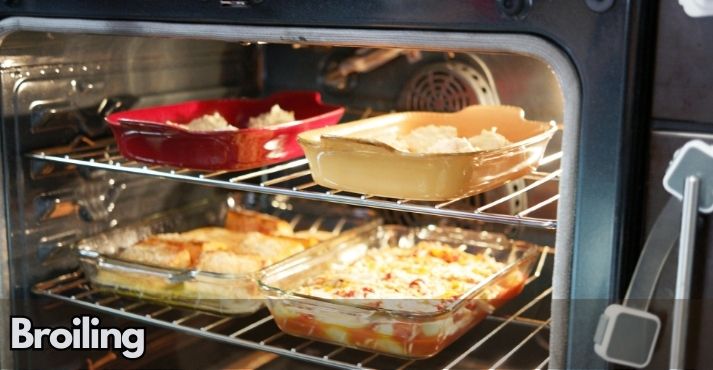
Broiling is a cooking method that uses high, direct heat from above, usually from the oven’s broiler. This method cooks food quickly, making it great for dishes that need a crispy top or a perfectly seared exterior.
Broiling is useful for cooking meats, fish, and even some vegetables in a fraction of the time it takes to roast or bake. The intense heat caramelizes the surface, creating a delicious, golden crust while keeping the inside moist and tender.
Broiling also affects the texture of foods in different ways. Since the heat is so direct, it helps create a slightly charred, crispy exterior while keeping the interior tender and soft.
This method is excellent for achieving a crisp finish on salmon fillets or steaks, just like in foodservice channels, where fast, high-heat cooking ensures meals are delivered quickly and efficiently.
Equipment Used in Broiling
Broiling requires some essential kitchen equipment to ensure the best results. Here’s a look at what you’ll need:
- Broiler Pan: A slotted pan that allows fat to drip away from the food while broiling.
- Tongs: Perfect for flipping or moving food without losing moisture.
- Aluminum Foil (Optional): Helps to reduce mess or prevent sticking, but it’s not always necessary.
- Oven Mitts: For safely handling hot pans and the broiler itself.
Simple Recipe for Broiling: Broiled Salmon
Broiling is a quick and easy method for cooking fish, and this broiled salmon recipe is no exception. It’s a healthy, delicious dish that comes together in just a few minutes.
Ingredients:
- 2 salmon fillets
- 2 tbsp olive oil
- Salt and pepper to taste
- Lemon slices (for garnish)
Instructions:
- Preheat the broiler on high.
- Place the salmon fillets on a broiler pan, skin-side down.
- Brush the fillets with olive oil, and season with salt and pepper.
- Place the pan under the broiler, ensuring the salmon is about 4-6 inches from the heat source.
- Broil for 5-6 minutes or until the salmon is cooked through and has a crispy top.
Tips:
- Since broiling cooks food quickly, keeping a close eye on your dish is essential to avoid burning. The high, direct heat can easily cause food to cook unevenly if left too long.
- Always leave the oven door slightly ajar while broiling for better air circulation and even cooking.
- It is important to understand how broiling affects texture when using this method. Foods will develop a crispy crust while retaining moisture inside.
- Broiling is a great option for quick, high-heat cooking, much like what you’d find in busy restaurant kitchens, where speed and efficiency are essential to satisfying guests.
Broiling is perfect for when you’re short on time but want to create a dish with a beautifully caramelized or crispy finish. With a few simple tools and a watchful eye, you’ll be quickly broiling your way to delicious meals!
Baking vs. Roasting vs. Broiling: Key Differences

Each oven-based cooking method brings something unique to the table. Whether preparing a delicate dessert, a hearty roast, or a quick-seared fish, knowing which method to use can help you achieve the perfect texture and flavor.
Here’s a quick breakdown of the differences in temperature, heat direction, and best uses:
| Method | Temperature | Heat Source | Best For |
|---|---|---|---|
| Baking | Moderate (325–375°F) | Indirect, all-around | Cakes, cookies, casseroles, puff pastry, and phyllo dough |
| Roasting | High (400–475°F) | Indirect, all-around | Meats, poultry, root vegetables |
| Broiling | Very High (500–550°F) | Direct, from above | Fish, steaks, melting cheese, crisp finishes |
Best Uses and Food Pairings
- Baking is ideal for baked goods like muffins, breads, cakes, and savory dishes like casseroles. It uses indirect, even heat to cook items slowly and thoroughly, perfect for recipes with essential moisture and structure. In a full-service restaurant kitchen, baking is often used to produce consistent results in high volumes, especially for desserts.
- Roasting works wonders on meats and vegetables, producing rich flavor and a caramelized exterior. It’s useful when cooking heartier ingredients like root vegetables, whole poultry, or large cuts of beef. The right kitchenware, like a sturdy roasting pan and meat thermometer, can help you roast like a pro.
- Broiling, on the other hand, uses direct, high heat from above to quickly cook or finish dishes. It’s perfect for a crisp, browned top, whether searing steaks or melting cheese on a gratin. The debate of broiling vs. baking for crispness usually comes down to time and intensity: broiling delivers faster, more intense surface crisping.
In commercial kitchens equipped with refrigeration equipment, these cooking methods are often used together — baking for batch preparation, roasting for depth of flavor, and broiling for quick finishing touches.
Choosing the proper technique impacts flavor and texture, making a noticeable difference whether you cook at home or in a professional setting.
When to Use Baking, Roasting, or Broiling
Choosing between baking, roasting, or broiling often comes down to the type of food you’re preparing and the result you want to achieve.
Each method works best for different textures, flavors, and cooking times, and using the right one can enhance your dish from decent to delicious.
When to Use Baking
Baking is best for foods that need gentle, even heat over a longer period. It works well for recipes requiring rising or setting during cooking. Whether using convection or conventional ovens, baking ensures consistent internal temperatures for reliable results.
Common examples include:
- Chocolate chip cookies
- Banana bread
- Mac and cheese casseroles
When to Use Roasting
Roasting works well for foods that benefit from high, dry heat and caramelization. It’s perfect for meats and vegetables that need to develop a crisp, flavorful exterior. For example:
- Whole chicken
- Root vegetables like carrots or sweet potatoes
- Beef tenderloin
When comparing roasted vs. baked food, roasted dishes often have a more intense, savory flavor due to higher temperatures and browning.
When to Use Broiling
Broiling is your go-to method when you’re short on time but want a crisp finish. It uses high, direct heat from above and is excellent for cooking thinner cuts of meat or adding that golden top layer. Ideal dishes include:
- Salmon fillets
- Steak or lamb chops
- Burgers or open-faced sandwiches
Broiling is also handy for quickly finishing a dish without drying it out, perfect for melting cheese or crisping breadcrumbs.
Tips and Tricks for Success with Baking, Roasting, and Broiling
No matter your cooking method, a few small adjustments can make a big difference in the outcome. Attention to temperature, timing, and equipment can help you get the most out of your oven and bring out the best in your ingredients.
Below are tips to help you get consistent, flavorful results every time:
Tips for Baking
- Keep your oven temperature steady and always preheat before placing anything inside.
- Use the right type of bakeware — glass, metal, and silicone pans can all affect how heat is distributed.
- Measure ingredients accurately and avoid opening the oven door too often, as it can lower the temperature and affect how your food bakes.
Tips for Roasting
- A sturdy roasting pan helps distribute heat evenly and can hold up to high temperatures.
- Rotate the food halfway through cooking to ensure even browning on all sides.
- Add fresh herbs, garlic, or citrus to the pan for extra aroma and flavor, especially when roasting meats or vegetables.
- A meat thermometer removes the guesswork and ensures your roast is perfectly done without overcooking.
Tips for Broiling
- Always preheat the broiler so your food starts cooking immediately.
- Position the oven rack based on how fast or intense you want the heat: closer for quick browning, farther for more gentle broiling.
- Keep a close eye while broiling. Food can go from golden to burned in a matter of seconds.
- Line the pan with foil for easy cleanup, and use tongs or oven mitts to handle hot cookware safely.
Conclusion
Baking, roasting, and broiling each have their place in the kitchen. Baking offers steady, even heat, great for cookies, casseroles, and breads.
Roasting is ideal for meats and vegetables, bringing out rich flavor and crisp edges. Broiling uses direct heat from above, perfect for fast cooking and adding a golden finish.
Your chosen method can change a dish’s texture, flavor, and overall result. Whether making a weeknight dinner or trying something new, knowing when to bake, roast, or broil can make all the difference.
Try mixing things up in your kitchen. Experiment with different methods, test new recipes, and see how each technique brings something special to your meals.
Have a go-to favorite? Share it in the comments — we’d love to hear what you’re cooking.

